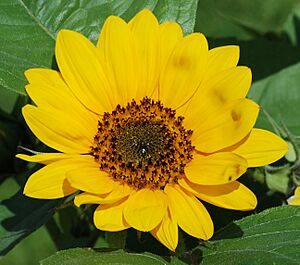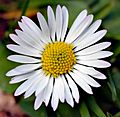Pseudanthium facts for kids

A pseudanthium (say: SOO-dan-thee-um) is like a "false flower." It's also called a flower head. Imagine many small flowers, called florets, all grouped together. They form one big structure that looks just like a single flower!
These special flower heads are common in the daisy and sunflower family, called Asteraceae. If you look closely at a sunflower, you'll see two kinds of florets. The ones in the center are called disk flowers. They look like the middle part of a regular flower. The ones around the edge, which look like petals, are called ray flowers. Each ray flower has one large "petal." This unique design is found only in the Asteraceae family. Sometimes, a plant might be missing one type of floret. For example, dandelions (Taraxacum officinale) only have ray flowers.
Even though a pseudanthium looks like one flower, it's actually a whole bunch of tiny flowers working together. This is a clever way for plants to reproduce. It means the plant can make many more seeds than a single flower. Plus, it often needs only one visit from a pollinator to get all those tiny flowers pollinated!
Contents
What is a Flower Head?
A flower head is another name for a pseudanthium. It means a group of many small flowers that grow closely together. They form one big, flower-like shape. This helps them attract insects or other animals for pollination.
Why Do Plants Have Flower Heads?
Plants like sunflowers and daisies use flower heads to be more efficient. Instead of having many separate flowers, they put them all into one big display. This makes it easier for bees and other pollinators to spot them. It also means that when a pollinator visits, it can pollinate many small flowers at once. This helps the plant produce lots of seeds from just one visit!
Examples of Flower Heads
You can find flower heads on many plants you might know.
- Sunflowers: These are a great example. The big "petals" are actually ray florets, and the center is made of hundreds of tiny disk florets.
- Daisies: Just like sunflowers, daisies have ray florets around the edge and disk florets in the middle.
- Dandelions: These yellow flowers are also flower heads. If you look closely, you'll see that every "petal" is actually a tiny, complete flower.
Images for kids
See also
 In Spanish: Pseudanto para niños
In Spanish: Pseudanto para niños











